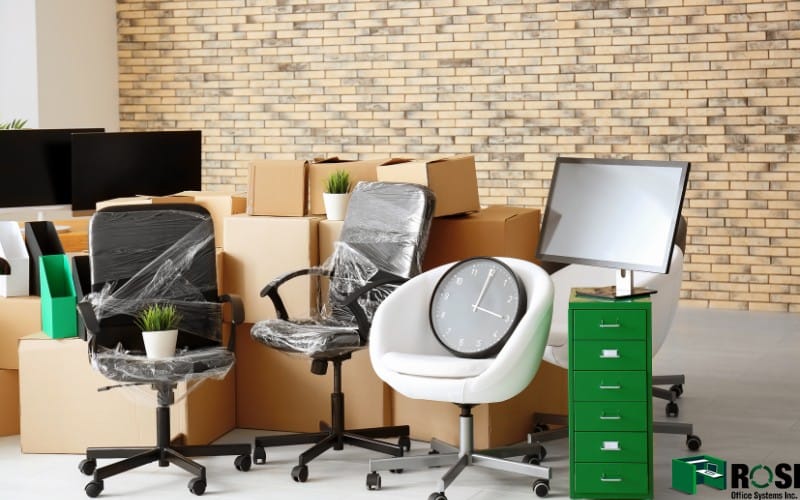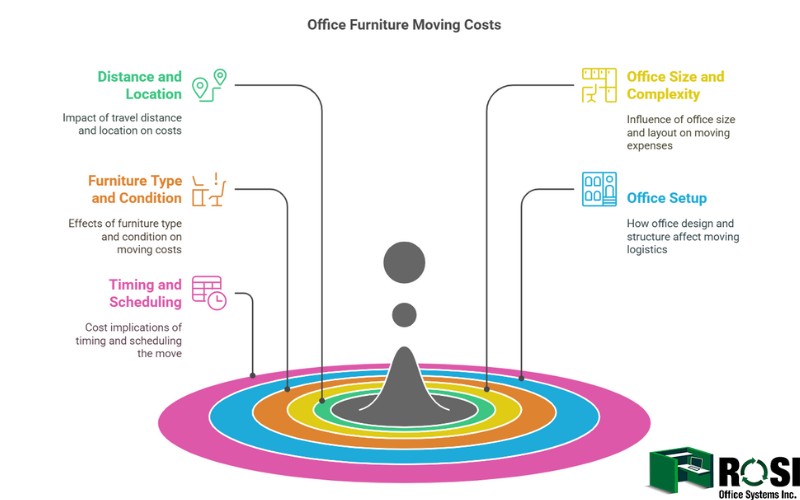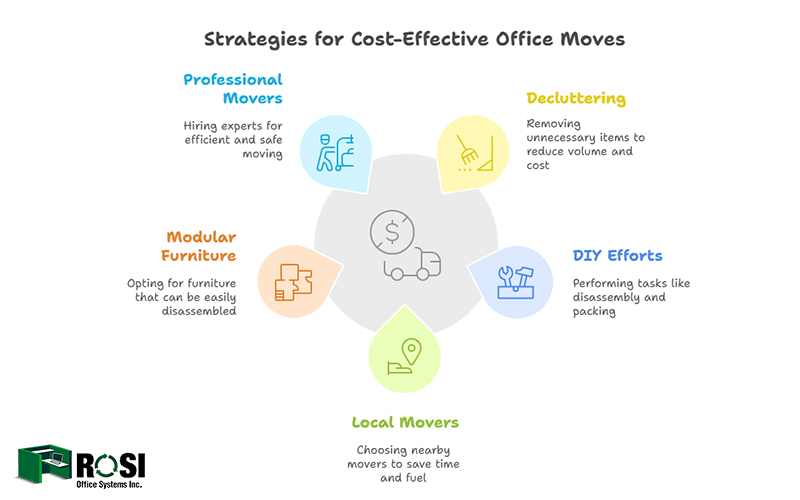
Many businesses, after years of working in traditional offices and achieving success, decide to move to a new and modern workspace.
Also, with the changes and growth of businesses and the increase in hybrid work styles, companies find the need to move office furniture and equipment.
Moving office furniture is a complex and important issue and brings concerns to managers.
These concerns include moving costs, time-consuming moving, damage to furniture and equipment, etc.
Various factors affect the cost of moving office furniture in 2025, so it is not possible to give an exact answer to the question of how much it costs to move office furniture in 2025.
But if we wanted to give an approximate answer this would be it: The cost to move office furniture in 2025 ranges from $200 to $1,500, depending on factors like the amount of furniture, distance, and labor required. Small local moves may cost around $200-$500, while larger or long-distance relocations can exceed $1,000. Additional services like disassembly and reassembly may increase costs.
To provide a comprehensive and accurate understanding of all the costs associated with moving office furniture so that you can better plan for your future office changes and relocations without stress.
The Essential Factors Impacting Office Furniture Moving Costs
Many factors affect the cost of moving office furniture.
The impact of each of these factors may be different for each office. Therefore, determining the cost of moving for each company is unique to that company.
1. Distance and Location Nuances
One of the factors affecting the cost of moving office furniture is the distance between two offices.
In local moves, costs are reduced due to the short distance and proximity to the destination.
However, in long distances, factors such as fuel costs, time, road tolls, urban traffic, and weather conditions are very influential in determining the price.
For example, transportation in densely populated urban areas is more expensive due to high traffic or in remote areas due to more difficult access.
These differences show that distance and geographical location are the key elements in determining the price of moving office furniture.
2. Size and Complexity of Your Office
The size of the office and the complexity of its design and office equipment have a direct impact on the cost of the office furniture relocation process.
Small offices usually have less and simpler furniture, but in contrast, large offices with several different rooms such as meeting rooms, conference rooms, and separate work areas have more equipment.
For example, large conference tables, private office cubicles, multiple chairs, and modular office furniture require more careful planning and more manpower to move.
In addition, the configuration of large office space usually requires more time to pack, transport, and set up in the new location.
This highlights the importance of choosing the right office furniture and working with professional teams to reduce costs and optimize the relocation process.
3. Furniture Type and Condition
The type of office furniture and its condition are some of the factors that determine the cost of moving it.
Regular and standard tables and chairs have a lighter weight and simpler structure, so they are easier to transport.
Specialized office furniture such as ergonomic chairs, and heavy filing cabinets, as well as sensitive office equipment such as monitors or specialized devices, require more careful transportation and packaging.
On the other hand, the condition of the furniture also plays an important role.
Furniture that is old or damaged may need to be repaired or replaced during the move, which also adds to the costs.
4. Office Setup
The design and structure of the office space, such as the number of floors and access to elevators, can make moving office furniture easier or more complicated.
In offices that are open-plan and have a large, single-story space, moving furniture is faster and less expensive because of the open paths and easy access.
However, if the office is on multiple floors or has tight spaces such as small hallways and long stairs, the moving process becomes more time-consuming and labor-intensive.
Also, if the office does not have an elevator, more manpower must be used, which increases costs.
5. Timing and Scheduling
Timing and planning are factors that affect the cost of moving office furniture because choosing the right time can significantly reduce or increase costs.
During peak times, such as the end of the holidays, when traffic is at its peak, the cost of moving office furniture is also higher.
Also, the timing of the move during business days or weekends is important.
Moving office furniture during business hours may cause disruption to the company’s daily activities and require more careful planning while moving during weekends or non-business hours can have additional labor costs but is more operationally efficient.
How to Reduce The Cost of Moving Office Furniture
1. Declutter Before Moving
Moving office furniture is about sorting and removing unnecessary items.
This step can make a significant difference in simplifying the moving process. Identify furniture that you no longer need or that doesn’t fit your new office.
Then sell it through online platforms to not only reduce the size of your belongings but also offset some of the moving costs.
Also, transporting damaged or unusable items to a new location is pointless and adds extra cost and time to the move.
It’s best to disassemble and remove these items from the office system before moving.
2. DIY Where Possible
You can do some of the work yourself to reduce the process of moving office furniture and its cost as much as possible.
Disassemble large pieces of furniture such as tables, chairs, and shelves yourself and with the help of your colleagues.
For example, disassembling the legs of modular office tables or shelves will not only make them easier to transport but also take up less space in vehicles.
With simple tools at hand, this can be done easily and does not require special expertise.
Other tasks you can do yourself include packing small items, accessories, and electrical equipment.
Using appropriate boxes and accurate labeling, pack items such as mice, keyboards, cables, office supplies, and personal equipment neatly.
3. Choose a Local Mover
Choosing a local moving company greatly reduces the cost of moving office furniture, especially when moving short distances.
These companies do not need to spend a lot of time and fuel due to their proximity to the origin and destination, in addition, many local companies offer special discounts to customers who are located in the same area.
One of the great advantages of choosing a local moving company is their complete familiarity with the routes and geographical conditions of the region.
Therefore, they choose more optimal routes and the moving process becomes faster and more efficient.
These companies usually have a customer-oriented approach and pay more attention to the needs and demands of customers to maintain credibility in the region.
Also, direct communication with company managers or representatives allows for better follow-up and faster resolution of potential problems.
If you want the daily activities of employees not to be disrupted and the office furniture to be moved quickly, you should use a local moving company.
Because these companies are closer to the location, they arrive faster and can provide more accurate scheduling.
You Might Also Enjoy: How To Soundproof An Office Cubicle: Top 10 Ideas
4. Type of office furniture
When you are planning to furnish your office, you can greatly reduce your moving costs in the future by purchasing modular furniture.
Modular office furniture is designed in such a way that its parts can be easily disassembled and reassembled.
This feature allows you to convert large pieces into smaller pieces when moving.
For example, modular office desks that consist of several sections can be easily disassembled and packed into small boxes.
This reduces the overall volume and weight of the load, and as a result, the transportation cost will be lower.
Multifunctional office furniture can also have different functions, which means that instead of carrying several tables, cabinets, and chairs, only one or two multifunctional pieces are moved.
Due to the lighter weight of many modular furniture, the moving process is faster and easier.
This reduces the need for additional labor for transportation, resulting in lower labor costs.
5. Choosing a Professional Moving Company
One of the most important decisions to be made in the office furniture moving process is choosing a professional and expert team in this field.
Asking for a professional team will make the moving process faster and more accurate and reduce costs by optimizing the moving process.
Also, a professional company will prevent damage to your office furniture by using modern methods and equipment.
Professional companies in office furniture moving usually provide a detailed plan in terms of time, proper packaging, and arrangement in the new office by examining the current and new space, the number and type of furniture, and transportation routes.
This level of planning prevents waste of time and resources and reduces final costs.
Conclusion
Moving office furniture is a sensitive and challenging process that may cause stress for managers.
But choosing a professional company with relocation office services can not only solve the challenges in creative ways but also reduce the moving costs as much as possible with careful planning and safe services.
So if you want your office furniture to be moved quickly, economically, and without any hassle, you can contact the expert team of ROSI.
Our team performs all the services required for moving, including disassembling and reassembling the parts in the new location, packing and unpacking the equipment, cabling services for audio and video in the new environment, testing the new office equipment, etc. with great skill and precision.
This smart choice can turn the moving process from a stressful experience into an efficient and successful process.

John Ofield is a recognized expert in the office furniture and office cubicle industry, with over 40 years of experience. As the founder of ROSI Office Systems, he specializes in space planning, custom cubicle designs, and high-quality commercial furniture. John’s expertise helps businesses enhance productivity and collaboration. He is also dedicated to mentoring entrepreneurs and redefining workspaces to inspire success.




